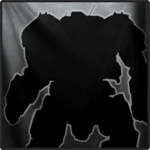There are 8 mechs on the enemy team. That means 8 fronts to avoid, and 24 back and sides to get to. With those numbers there's no excuse for failure
Aggro
You may be familiar with the concept of aggro. Aggro essentially means attention, or focus. If you have someone's aggro, they are focussed on attacking you. A person will direct their aggro depending on a number of factors, the main influences of which are:
There is only one viable target: If there is only one target for a player's aggression, that's where the aggression will go.
Ease of doing damage: A player might pick a target because they perceive it to be the easiest target to damage or kill. Factors that influence this include the distance to the target, the speed the target is moving, how tough the target is, how damaged the target is, how much cover the target has, if there are other team members attacking it, or if it is attacking one of their own team members.
The weapons an enemy has will also determine how likely they are to attack you. For example, a short range mech is more likely to ignore you at long range than a long range mech.
Their currently selected target: Players are much more likely to pick a target they are already facing, and also a target they already have selected. Turning and locking targets (gathering target information) both take time, so it is easier to stick to whatever target you currently have selected. Forcing your enemy to turn and switch targets is one of the goals of flanking.
Who is attacking them: When you attack a player, they are much more likely to direct their attention towards the attacker. This is because you pose a threat to them. Players will almost always turn to face you when you attack them, unless there is another bigger threat that prevents them from doing so.
There are many other factors that will determine if a player will attack you, but just keep in mind that you are more likely to be attacked if attacking you is easy, or if you are the biggest threat.
What does all this mean for flanking? As I have described in my other guides (linked below), flanking is important to manage the aggro of the enemy team, to maximize the damage you deal while minimizing return damage.
When to flank
Simplistically speaking, at the beginning of a match you will be taking on one of two roles depending on the mech you're in. If you're in a tough, slow mech, you'll be acting as a blocker - halting the enemy advance and forcing them to take cover. You are the front line. Hold ground, and hold the enemy in place.
For lighter, faster mechs, you must not engage the enemy before the battle line is formed. If you engage the enemy before they are occupied by your assaults, they will direct all their attention at you, and probably kill you. Instead, spend the time at the beginning of the match moving through cover to get to a position where you can hit a flank of the enemy once the battle begins.
There is no point in flanking an enemy unless something good results from it. You can't distract an enemy that isn't doing anything. You can't kill the enemy team on your own. You can last long if the entire enemy team shoots at you. The entire enemy team will shoot at you if you are the only target.
How far in to go
You should only engage the enemy when you can do so safely. Safely means without taking more damage than you will deal. Damage refers both to direct damage from your weapons, and indirect damage from giving your team mates an opening to deal damage. Safely does not mean avoiding getting noticed or shot at. While hiding behind cover will keep you safe from the enemy, it will also keep the enemy safe from you. You must always be doing something, even if that something is just moving to a new, better location.
Do not "wait" for the enemy or "hide" unless you have a good reason to do so. Setting up an ambush is a good reason (assuming that ambush will occur soon). Hiding when you are outnumbered so that you can escape is a good reason (assuming escaping will help the team and you don't hide too long). But if your team is fighting and you aren't helping, your team is effectively a mech down.
The extent you commit to a fight is determined by how occupied the enemy is, how many of them there are, how easily you can kill or disable the enemy, and how easily you can escape after you've entered battle. These are your goals as a flanker, in increasing order of importance:
1. Distracting the enemy
2. Damaging the enemy
3. Killing the enemy
The extent to which you commit will depend on the extent to which you can complete your goals. The risks you face are:
A. Getting enemy aggro (they attack you)
B. Getting damaged
C. Getting killed
Trade A, B and C for 1, 2 and 3. Make sure that you take more from your enemy than you give. Also remember that MWO is a computer game, so the enemy weapons won't hurt you, only your mech, and if your mech dies it'll respawn very soon. Don't be concerned with death, only with victory.
Remember that simply standing on a flank does nothing. You have to distract, damage or kill the enemy or you're wasting your time. Getting killed also does nothing unless you trade that death for a lot of death in return, or give your team a decisive advantage and can win the game without you.
Questions to ask yourself
Is doing this going to get me killed?
Is doing this going to help my team?
Some useful techniques
Look at your map, not just for the enemy, but for your own team. Try to discern where the enemy's attention is focused (so that you can avoid it), and where your team is applying pressure (to know who will be distracted).
Watch where enemy missiles are coming from. If they are coming from an isolated location, there is probably an LRM boat waiting to be killed there.
When shooting or scouting, poke out from cover for as little time as possible. When shooting, try to be out of cover only when you're actually firing, and stay behind cover while your weapons (or mech) cools down.
A good way of using cover is to move forward and back in a straight perpendicular to the direction of your target. Line your feet up such that you can move in and out of the cover without having to turn, turning only your torso towards your target. Doing this ensures you don't get caught on the cover when trying to return, or have to turn around out in the open.
If you take return fire when returning to cover, turn your torso away from the shots while backing away. This not only presents a smaller profile to the enemy, it also protects your center torso.
Sometimes it's better to move between two pieces of cover, rather than staying behind one. This avoids having to stop and reverse (presenting a non moving target to the enemy). To do this, line up the direction you want to travel with your legs and only move your torso to aim. This ensures you'll get to where you're going without having to look and without bumping into anything.
If the enemy starts coming towards your cover, you can retreat. Try to move into a new covered position from where you can fire on your last position, or just try to escape the situation. When retreating, the earlier the better. The closer the enemy gets, the harder it is to get away.
Where to hit enemy mechs that don't know you're there
The best places are the back center torso and the legs. The back center torso will take longer than a leg to kill, but you have to kill both legs to kill a mech and they can be harder to hit if they are moving. The benefit to taking out a leg however, is that you can disable the enemy.
You might also want to consider hitting badly damaged components. Knocking off a badly damaged arm might be an easy way to reduce the effectiveness of an enemy mech. Walking around to the front side of a mech might also be worth doing if they have no front armor and you have a high alpha.
If you want to move around a particular side of a mech after engaging, try to hit them on the other side. For example, if you want to run to the left side of a mech after engaging them, hit them at least a little bit on the right. This will encourage them to turn towards the right and make it easier to avoid their weapons.
That's enough for now, thanks for reading. My other guides:
Some tips for new players - http://mwomercs.com/...yers-pps-guide/
Combat: What to do and why - http://mwomercs.com/...-and-why-by-pp/
Mech roles in combat - http://mwomercs.com/...35#entry2545335





















